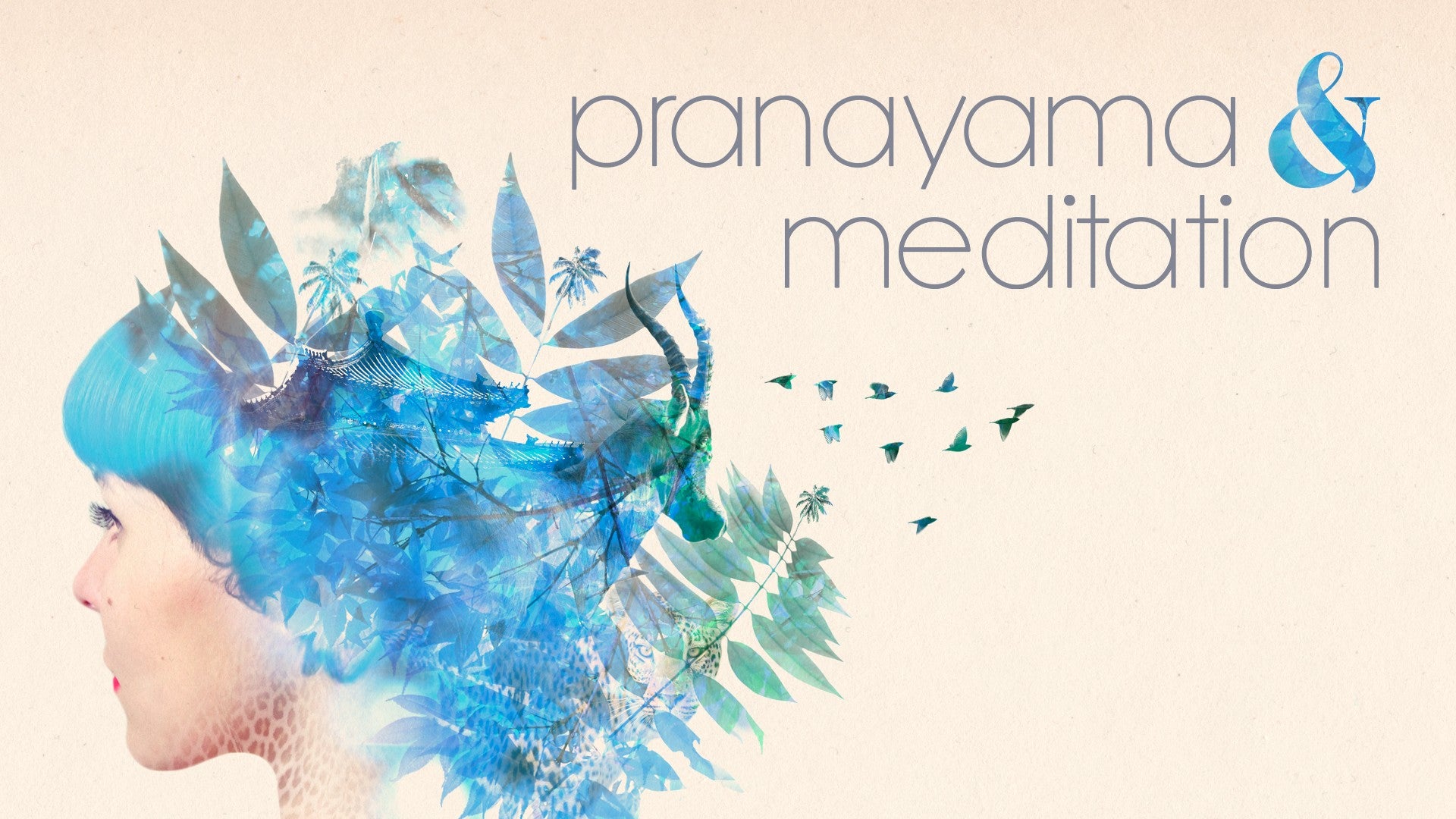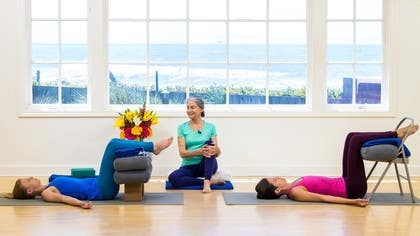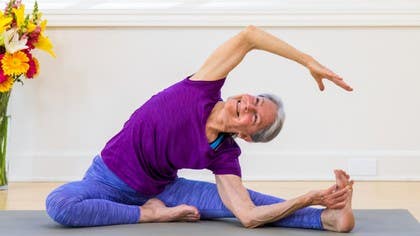Description
About This Video
Transcript
Read Full Transcript
Hey there. Here we are set up with Satrine and Rosemary again. We're going to do some reclining breath attention with the legs at 90 degree angles, and then we'll bring it up to sitting. So sometimes we call this posture, this setup here stone hinge, the two blocks and the plinth across the top. And it can also be done with the chair. There's a lot of ways to get you, you could put your feet up on a bed. That's all you have. Okay, so I think I'll start showing Satrine how to get into this particular variation. If you just come onto your side and roll up and you're going to get your calves all the way to the knee joint, set up on that. And as you move into your prop and get your body set up on it, you can't really see your body. I can see her body, but you can't really see your body. But what you want to feel is that your thigh bones are coming straight down into your pelvis. And if you're not sure what you should be looking for, is feeling for, looking for inside, is just the sense that there's a rightness to the way the thighs settle into the socket. So I'm going to give Satrine one more blanket. And if you're able to see that, you can check it out. Otherwise, just feel it on your own body. Do I need more height? You can always measure the length of your thigh bone. You measure the length of your thigh bone. You know how much height you need here. So when that happens, I just heard Satrine sigh. So that was a good sign. And I'm going to ask her, you and her, to place your hands palm up next to you and out a little bit so there's a sense of openness under the armpit area. It's about a 45 degree angle. And to really have your palms and fingers as soft as you can make them, limp. Okay? Everything's settling. Okay. So if you're using a chair, it's the same thing. You need to take into consideration the length of your thighs for the, that's the height of your cushion. So Rosemary is going to get in. As you set yourself up, you want to get, you want to know that feeling inside if you don't have a mirror right next to you. You can see it in this video, in the show. And then for both of you, I'd like you to, yes, good angle of the hands, nice and soft. For both of you, I'd like you to roll your legs out and in just a little bit from the knee area and then let go. So it's a kind of a, just a floppy movement to release, help release the thighs. When the thighs sit very deeply into the socket this way, your pelvis begins to find its proper position. So many of us have little rotations or elevations, elevation and rotation in the pelvis and this starts to unwind it. And when that unwinds, so too the rest of the back. And so you might just find this really delicious. This is my napping position. I set the timer for 20 minutes. Sometimes I, I'm ready to move in 10, but it's so refreshing. All right. So the breathing that we're going to do with this is a sense of, we're going to work with a little bit of lower abdominal contraction at first to help to release the abdomen, abdomen muscles and also to release the diaphragm muscle and let it to, to move more freely. So I'm going to ask these two to at the end of the out breath, when you feel like you're ready to breathe in instead of breathing in, you're going to gather your abdominal muscles and press downward towards the floor, back towards your back and just hold for a couple of seconds and then let go and truly let go. And notice the way the breath comes back in for you. And let's repeat this a number of times. You're only pausing for a couple of seconds long enough so that when you let go, your nervous system feels the let go and it's ready to allow the breath to flood back in, in a really nice way. And sometimes it's a slow flooding and sometimes it's quicker. The breath is silent. And as you do this, you might begin to feel the breath come up higher into the chest than it normally does.
You might begin to feel that there's a deeper in breath coming down towards your pelvis because of releasing perhaps a tight abdomen by this brief hold and then letting go. So it becomes a more thorough breath without effort. When we're working with Pranayama, we want the effort to be very minimal. It's more the concentration and the listening that we're doing and not so much the doing that we're doing. So I believe these two have probably done this at least 10 times and that's a good number. You could do it for longer. You can have your eyes open or closed. I notice that Satrine's eyes are open but very calm and I notice that Rosemary's are closed. So they're doing what comes natural to them and I suggest that you do as well. So we're going to, I'm going to ask you to let go of the abdominal contractions now and just notice what your breath is like having worked that way for a little while. Notice the places where you feel the breath is more present and where you're more present with the breath than before. And there are many other things that you might notice. And now we'll transition into an actual exercise of breathing that that should have prepared you for, which is to imagine that you're breathing in and down, which you would have been feeling already with this, but that the in and down continues to fill upward towards your heart space, maybe a little above the heart space. And then as you let the breath out, you're letting the chest and heart space relax down to the lower ribs and ending with the belly. The belly is sort of a contradictory idea, but the belly is releasing the breath out on the one hand. And on the other hand, there's a little bit of muscular work that's always coming from the belly to release the breath out. So breathing in and down in order to breathe up and then letting the chest relax. And then the belly releases and then you're empty again a couple more times. You might feel a longer breath that your breath has become longer. You might start to feel that your breath is getting shorter or that you're starting to feel like it's hard to keep up this pace. And that is a sign that you are ready to let go of guiding the breath. So I'm going to ask you to let go of guiding the breath for now and just see how the breath wants to breathe. We'll call this normal breathing, which is normal breathing is whatever your breath wants to be doing in this moment, in each moment. What's it like for you now? And then we're going to usually two or three breaths of breaking from a guided breathing exercise. Two or three breaths is enough, but you have to be judged, the judge of that. We're going to change the way we breathe out in this exercise. So after your next exhalation, as you breathe in, you're allowing the breath to come, if you can, all the way down to the bottom of the pelvic floor into the sacral area and gradually work its way up to somewhere in the chest. When you breathe out this time, imagine the chest is still expanding and let go of the breath from your belly first and then let go of that sense of expanding and let the lower, middle and upper chest release completely and then don't take another deeper breath. Just give yourself two normal breaths and notice what happens because if you try too hard, you'll feel it. You might feel your heart racing a little. If you don't feel anything unusual, fine. And then we'll do that again. So as you finish your next exhalation, you'll breathe in, letting the breath come down into the belly and the back and the lower ribs and somewhere upwards of the heart space without strain, eyes releasing down, pause, continue to feel your chest expanding your heart space as you let go of the breath from above the navel downward and then you'll feel the right moment whenever it is to start letting go of the chest and then please another two cycles of normal unregulated breathing. Feeling into that. What's happened? Oftentimes you'll be hungry for more. If you're watching this video, you'll see that I from time to time look at my two students' friends because when I was learning about Pranayama, my teacher told me, don't just fiddle around when your students are doing Pranayama. Watch them. You will learn so much. And one of the things I've learned is if I'm teaching Pranayama, I do not allow my students to wear black. I beg them, please do not wear black today. I can't see a thing. So black hides. All right. So let's do two more of those breaths with one to two cycles of normal breathing in between. So you're going to be breathing in and down to fill up. Always feel like you're pouring down to fill up with the eyes and the skull releasing down towards your heart and then expanding, gently expanding the chest as you begin the exhalation in the belly. One to two resting breaths and then a second cycle like that. And I'm going to be quiet for a couple of minutes to let you do that. Diving your brain and eyes into the heart space. It's devotional.
I don't know about your pace at home. You might even be on your third deeper breath. That's fine. So when you have finished an out breath in this cycle, this next one that you're doing or the one you're on now, let go of guiding the breath and give yourself two resting breaths, normal breaths, before you roll over to your side and we'll come up to a sitting position. So I'll give you a few moments to do that. And be on your side for a couple of breaths before you push up and use your freer hand. If you're lying on your right side, that's going to be your left hand, left hand and left arm to push yourself back up to seated. For this particular practice, I see two very soft faces in front of me, which is delightful. So now I'm going to show you at home two different sitting positions that you can play around with and I'm going to work with Satrine first. All right. So Satrine is going to be sitting on two blankets and you might like to have two blankets yourself, but maybe you'll be happy with one. What I like about the two blankets is that you can get, it's very easy to get this little bit of upward curve, inward and upward curve in the lower back when you have plenty of height without overusing the psoas, the groin, and also without overusing the forward movement of the lower rib cage.
So why don't you show them what that looks like? Yeah. So this is how we can maybe get the feeling of an upright spine, but it gets exhausting on the back and we can't really hold it. You can't really breathe well in this because you're blocking the back of the diaphragm. So go ahead and come back. Very good. And then the other thing is she's got a lovely posture right now, but is to make sure that the base of the skull is lifting off the back of the neck. So the posture is being supported from below by having a little bit of low back arch here, an easy relaxed one, and supported from above by the sense of the skull being lifted at the back. So that's sitting cross-legged on the ground. And then I'm going to have Rosemary demonstrate sitting in a chair. So she's got long legs and she's going to use a blanket under her hips. And for the same reason that I've got a couple of blankets with Satrine is so that she can get that nice easy lift of the lower spine without having to hinge forward from the lower ribs. And you could soften back a little. Just that tiny bit of softening back makes such a huge difference. It feels softer. Yeah. It looks softer. Okay. So that's the posture that we're going to be using for the next little while with the similar breath to what you were doing lying down. I'm going to call this dome breathing. And the domes in the body are actually sometimes called diaphragms. They separate one part of the body either from the outside world or from another part of the body. So we have a pelvic diaphragm which can rise and descend right at the pelvic floor. We have the diaphragm that we breathe with which separates the abdomen from the lungs and heart space. We have a diaphragm here where we can close off the throat and hold the breath or swallow. We have this miraculous ability to breathe and not have the breath go into the stomach. And we can drink and eat without having those items go into our lungs. So this is the very intelligent part of the body here, this particular diaphragm. And then there is one inside the skull which I'm not sure if there is a diaphragm in the skull. But if there isn't, even imagining that it's there is helpful. So four domes. And I'm going to ask you to start breathing simply down. So first of all, release your breath out. Feel yourself empty without harshly emptying. And then relax your belly and see if you can feel the energy of the breath touching down as you relax your pelvic floor to receive the impetus of the breath. And then some of the breath will come up. And then breathe out again. Maybe the pelvic floor will feel like it rises, maybe not. And as you breathe in again, let the breath come down. I sometimes imagine there's a very large balloon under my body that I'm filling deep into the earth. It's very, very grounding. Okay. And on your next inhale, I want you to see if you can feel this diaphragm around the ribs also descending. So your diaphragm is dome shaped. Your breathing muscle is dome shaped, but it flattens out a little bit in order to create the reverse pressure for your breath to come into your lungs. So that's the structural aspect, but the energetic aspect of feeling the area around the ribcage and the pelvis receiving the breath as it comes in is quite a wonderful sensation. So those two domes are going down with the in breath and they're possibly sort of rebounding back up a little bit on the out breath. Okay. Now this diaphragm up in the throat area, as you breathe in and down and you feel the two lower domes descending, can you feel this upper chest wanting to rise and this dome actually lifts up a little bit. And although we don't want the outer structure to collapse when we breathe out, we do want to feel and allow for this throat diaphragm to soften on the out breath. So it softens down while the thoracic part in the ribcage will come back up on the exhalation. So we've got down and up. This is a theme in breathing all the time. Down and up is happening together. So we come to the brain. You've got your other three, two going down, one coming up. And the brain goes with the chest and pelvic diaphragm. So as you're breathing in, if your eyes are open, you really want them to descend, just let them release downward and feel that the brain is shrinking a little bit and softening and pouring down. It's like you're shrinking the ego out of just wanting to connect with this sensation of the breath. So in and down, all the domes going down except for the throat, which allows the rising of your chest. And then as you breathe out, the throat and brain diaphragm continue to go down. The other two, the other two domes rise up again a little bit. So I'm going to let you take a couple of breaths on your own with this. If you have begun to feel like, oh, I'm getting tired of this or I'm having to grasp for the next breath or the breath is getting shorter, it's time to take a couple of resting breaths. Otherwise you can do two to three of these dome breathings in a row.
Tongue is soft. Base of the skull open. As you're finishing the breath you're on now, I'd like you to just allow your breathing to find its own pace, to be as concentrated and interested and in love with your breathing as you have been while you've been working with it, guiding it. And just to see what it wants to do now, feel into what is its natural quality now. What is the quality of your existence, your mind, your heart, your psyche? You're not really trying to answer these questions, you're just entertaining them. Who or what is actually doing the breathing? Sometimes you might feel the unbinding of time where I and me and mine do not exist. And what might that be like? As you sit like this, your eyes can be open or closed, just another minute or two. If they're open, they're relaxed, receiving each moment. As you sit like this, your mind can be open or closed, just another minute or two.
And as we let go of these moments of meditating, let the transition be slow and gentle, just introduce the idea that you're going to be getting a little more active again in a moment. And then bring your palms together in front of your heart, feel the sensitivity of your hands, gratitude perhaps for this time of being with yourself in a very different way. Namaste.
Pranayama & Meditation: Patricia Sullivan
Comments
You need to be a subscriber to post a comment.
Please Log In or Create an Account to start your free trial.











